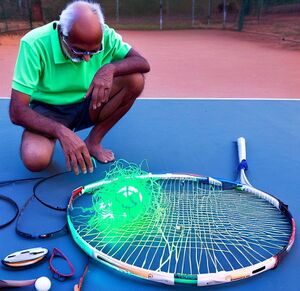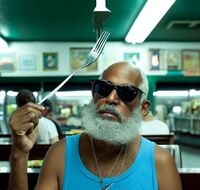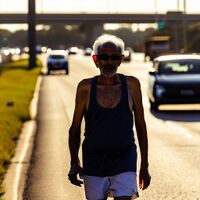Special Composition: Difference between revisions
imported>Jacob Robertson No edit summary |
No edit summary |
||
| (21 intermediate revisions by 2 users not shown) | |||
| Line 1: | Line 1: | ||
{{ | {{Lens | ||
|Name=Special Composition | |||
|LensShadowDescription=no | |||
|AdditionalOverview=Special Composition is about recognizing relationships in a way that makes it easier to embrace [[Adaptation]] and {{Credo|Adaptation}}. Examples are given below, but a very simple example is a highway. | |||
* A highway | * A highway | ||
** With four or more lanes | ** With four or more lanes | ||
| Line 14: | Line 13: | ||
** Some are different (cars vs semi-trucks) | ** Some are different (cars vs semi-trucks) | ||
This is really just a starting point to understand the concept. If you find yourself noticing | This is really just a starting point to understand the concept. If you find yourself noticing Special Composition, relax your mind and experience the following types of things. | ||
* Play with your own perception, seeing systems in different ways, especially moving between the different systems you see (highway and vehicles) | * Play with your own perception, seeing systems in different ways, especially moving between the different systems you see (highway and vehicles) | ||
* Within a system, notice there are parts (lanes, individual cars). Feel that they are just "parts" - they aren't the whole picture. | |||
* Notice how easy and arbitrary it is to divide and combine things into systems that work together. This is an important step in understanding [[Adaptation]]. | |||
|Beacon=Adaptation | |||
|Sort=Lens_S01500 | |||
}} | |||
Latest revision as of 18:13, 20 September 2023
 | |
| Lens: Special Composition | |
|---|---|
| Beacons | Adaptation |
| Landmarks | Observe Parts of a Whole Perceiving Parts as a Whole |
Lenses, in the context of the Beacons of Everyday Enlightenment represent more specific concepts and practices through which we can understand the rich meaning of each Beacon. There are Primary Lenses, which are the most commonly understood and most robust meditative concepts, and there are Other Lenses which are a collection of other closely related ideas for that Beacon.
The idea of Special Composition is about recognizing that the world as we experience it is broken down into many, many arbitrary ways of conceptualizing how things work together or against each other. Special Composition touches on each of the Beacons, but is placed within the Beacon of Adaptation because it deals primarily with the way we perceive "things" which enables the other Lenses of Adaptation such as Non-Seeking and Impermanence. Special Composition is about recognizing relationships in a way that makes it easier to embrace Adaptation and Embrace the Change. Examples are given below, but a very simple example is a highway.
- A highway
- With four or more lanes
- Some are going in the same direction
- Some are going in the opposite direction
- On the highway are vehicles
- Some vehicles are traveling in the same direction
- Some are traveling in the opposite direction
- Some are similar (red cars)
- Some are different (cars vs semi-trucks)
This is really just a starting point to understand the concept. If you find yourself noticing Special Composition, relax your mind and experience the following types of things.
- Play with your own perception, seeing systems in different ways, especially moving between the different systems you see (highway and vehicles)
- Within a system, notice there are parts (lanes, individual cars). Feel that they are just "parts" - they aren't the whole picture.
- Notice how easy and arbitrary it is to divide and combine things into systems that work together. This is an important step in understanding Adaptation.
Landmarks
The Realms of Everyday Enlightenment each have some noticeable Landmarks which show the likely alignment someone within that Realm has with each of the Beacons and their various Lenses. These Landmarks are things that need to be noticed and explored in the context of those Lenses and Beacons. And then through working on the Trails and Guides these Landmarks will serve as markers toward the next Realm where new Landmarks await.
Landmarks of Enrollment
Landmark: Observe Parts of a Whole
 | |
| Landmark: Observe Parts of a Whole | |
|---|---|
| Beacons | Adaptation |
| Realms | Enrollment |
| Lenses | Special Composition |
| Guides | Eating |
The Landmark of Observe Parts of a Whole is a first step in seeing some common things as parts of a whole.
Review these questions to see if you have fully explored this Landmark and are ready to move on.
Landmark Lookouts:
- Notice the Part: Can you see something and recognize that it is a "thing" but at the same time know it can be grouped together with other things to form a whole?
- Notice the Whole: Can you see something that is a "whole thing", and at the same time recognize that it has parts that are independent?
- Notice Other Wholes: Can you recognize that some "things" are part of more than one "whole", and some wholes share parts with other wholes?
To get a glimpse into the flexible nature of our concept of "parts and whole," we can mindfully observe the things around us during any meal or snack. Try each of these at different times and see if you get that glimpse. Take your time to think about each of these ideas, and don't necessarily do all of these during one meal.
- When you use a fork, do you consider that you have a handle, and the tines of the fork? There are really two halves to the fork in terms of utility, and some forks might even have a wooden handle and metal tines. Beyond that, you may think of the tines as one useful side of the fork, but try stabbing something small with just one of the tines. For that one moment, can you sense that each of the tines is its own thing? For a fork, it seems obvious it is "the whole" because it is forged from one piece of metal. However, each part can be considered alone as well.
- What is your drink, or more specifically, what about the drink you see in front of you is necessary to maintain its identity? We know liquid is made of molecules, or even more simplistically "drops". But what happens if you take a sip of your drink? Is it now a new drink? Was that sip part of the drink? If so, it wasn't a mandatory part of it.
- Other things around you such as chairs and tables are clearly made of parts, but we rarely need to think about that. But once you start listing the parts of a chair, it's very obvious that the parts (the legs, seat, back) are fairly uninteresting compared to the whole chair itself.
- A sandwich is the perfect example of something that is both "the whole" and "the parts" at all times. A sandwich (or anything comparable) is so dependent on the parts being distinctive, but working in harmony. As you eat, think about what it would be like if one of the toppings wasn't there, or if it was all blended up first, or if you were to eat each part separately. The experience wouldn't be the same at all.
Landmarks of Engagement
Landmark: Perceiving Parts as a Whole
 | |
| Landmark: Perceiving Parts as a Whole | |
|---|---|
| Beacons | Adaptation |
| Realms | Engagement |
| Lenses | Special Composition |
| Guides | Walking |
The Landmark of Perceiving Parts as a Whole is a chance to perceive how a lot of things we see everyday can be grouped together naturally to form nearly arbitrary "wholes".
Review these questions to see if you have fully explored this Landmark and are ready to move on.
Landmark Lookouts:
- Notice the Parts: Can you see things that are similar in some ways and could be grouped together (such as cars and trees)?
- Think About the Parts: Can you see all the ways that these types of "parts" (cars, trees) are both similar (in appearance, purpose, motion, etc.) and yet still individual?
- Think About the Whole: Can you shift your perception to see a new type of whole - individuals (cars, trees) with their own purpose, but all part of an interconnected system?
There are many exercises you can do while Walking, including the following Special Composition concepts. Depending on where you walk, try out some of these ideas.
- Trees - individuals, clusters, trees of the same species, etc. - How are they individuals, and how are they parts of a whole?
- Sidewalks and the grass next to them, parallel to the road, parallel to the sidewalk across the street - Even though the sidewalks are not "one thing", they are clearly two halves with the same intention - to allow people to walk along the road.
- Streetlights - alongside the sidewalks, in the grass, lighting the street - These are connected through an electric cable, they would typically light up at the same time, and yet they are individual lights that don't seem to be part of a whole. Look now at all the streetlights you can see, and notice how they are in fact one thing - the night-lighting for that area.
- Telephone poles - similar to the streetlights, but not the same at all - Clearly a street light isn't connected to a telephone pole. But do all the telephone poles and all the streetlights fit together into one system? What is that system? Does it include the sidewalks and streets, and why?
- Cars - think about the different ways cars are related. One car - just going somewhere. Two cars - staying safely away from each other and matching the same speed. All the cars - working together to move forward in a way where everyone can get where they want to go. Opposite lanes (going in different directions) - are these separate things just because they're going in different directions, or are they still all part of one system of getting people and things where they need to go?
- People walking in the same direction, and in the opposite direction - all the same ideas as with cars, but now it's much easier to see the intention and individuality. Is there a "whole" when thinking about all the people you see? What about "all the people who chose to walk here today" - is that a "whole"?
Landmarks of Enrichment
Landmarks for this Realm (Enrichment) will be added here when those pages are created.
Resources
- Mereology - "In logic, philosophy and related fields, mereology ... is the study of parts and the wholes they form."
- Material Composition - "A material composite object is an object composed of two or more material parts. The world, it seems, is simply awash with such things."
- Different Answers to the Special Composition Question - "Our intuition tells us that four legs and a tabletop make a table and that four walls and a roof make a house. However, I think we can all agree that a birdhouse and a pair of shoes do not compose a further object. The Question of Material Composition seeks to find the reason for this."
